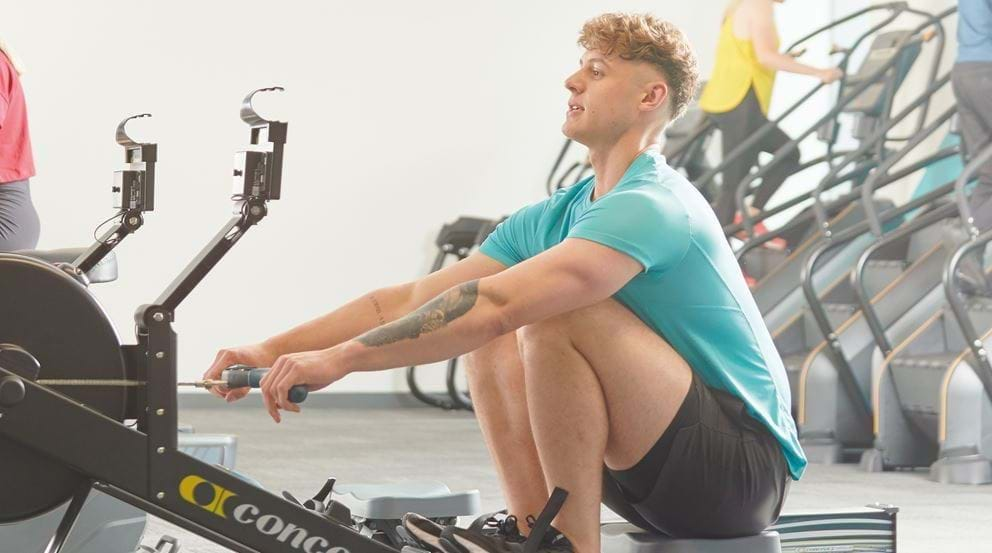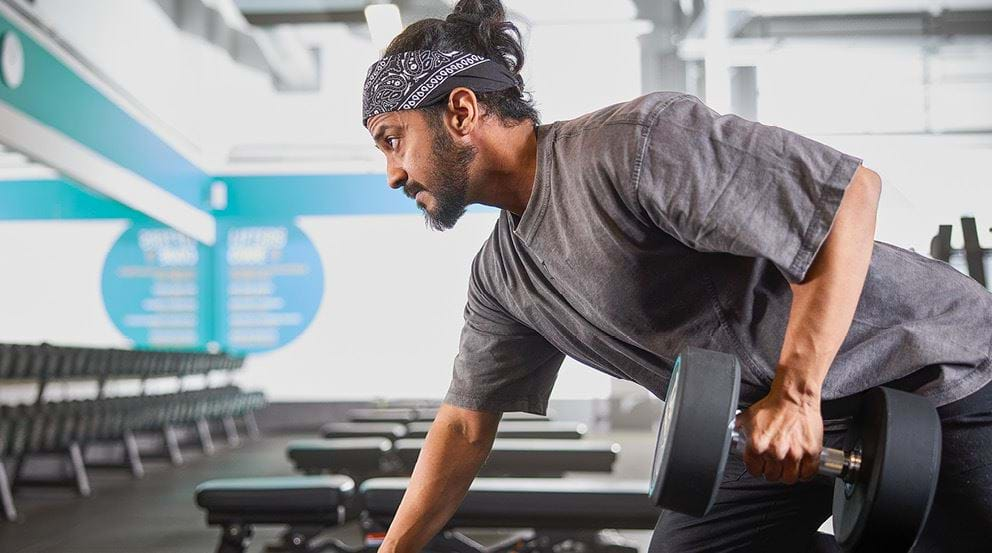HIIT Rowing Machine Workouts To Try In The Gym

The rowing machine is one of the most popular cardio machines in the gym, and for good reason. It offers a low-impact, full-body workout that boosts fitness, burns calories, and releases endorphins.
Many people enjoy putting on some music and zoning out for a long, steady rowing session, and we've written about the many benefits of the rowing machine here. However, if you're looking for a new challenge or would like an effective workout in a shorter amount of time, you could consider giving HIIT rowing a try.
Is Rowing HIIT?
Rowing as an exercise, or even a hobby, is usually conducted as low-intensity, steady state cardio. However, it can easily be structured to become a HIIT (high-intensity interval training) workout as well.
HIIT is a training approach that involves alternating bursts of intense exercise with periods of lower-intensity movement or rest. Rowing, whether that's on water or on a rowing machine, is an excellent cardio exercise that can easily be adapted to fit a HIIT format by incorporating these short intense bursts into your session.
You can read about the different types of cardio here.
Can You Do HIIT On A Rowing Machine? And What Are The Benefits?
Yes, you can absolutely do HIIT workouts on a rowing machine, and it's a great way to get all the benefits of a rowing workout in a shorter space of time. HIIT rowing workouts are an incredibly effective way to burn calories, improve endurance, and build strength, all from one piece of equipment.
We've written before about the benefits of HIIT workouts in general, but there are also many reasons why rowing machine HIIT in particular can be a good choice. These include:
Burns more calories: HIIT on a rowing machine can help you burn more calories in a shorter amount of time when compared to rowing for longer at a steady state due to the level of intensity performed at. If your goal is to burn calories and work up a sweat, this means you can squeeze an effective workout into 20 minutes rather than needing, for example, an hour. HIIT workouts continue to burn calories throughout the day too, giving you even more bang for your buck.
Increases cardiovascular fitness: Rowing is an excellent cardio exercise that can help improve your heart and lung health. With a HIIT approach, you'll challenge your system even further by pushing your body to maximum effort during the high-intensity periods, which increases the threshold for your cardiovascular fitness.
Gives a full-body workout: The rowing machine provides a full-body workout that engages multiple muscle groups, with the legs, core, back and arms are all challenged during a rowing session. This means you can work and strengthen your whole body using one piece of equipment, in 20 minutes.
Builds strength and endurance: While rowing machines are predominantly seen as a cardio exercise, they help to build strength and endurance as you must row against resistance. Rowing at high intensity can build speed and strength while improving endurance. Over time, you can increase the speed and resistance and continue to challenge your body and improve your fitness levels.
Low-impact exercise: If you're prone to knee or joint pain, you'll be happy to hear that rowing is a low-impact exercise that puts less stress on your joints than high-impact exercises like running. You can enjoy all the benefits of a high-intensity, high-energy workout, without putting any unnecessary strain on your body.
Time-efficient: If you're tight on time and struggling to fit a full body workout into your day, then HIIT on a rowing machine can be a time-efficient way to build your fitness and strength in a short amount of time. By incorporating short, intense intervals, you can get an effective workout and improve your fitness in as little as 10-20 minutes.
How To Do HIIT On A Rowing Machine
When starting a HIIT workout on a rowing machine, it's best to begin with a warm up -- around 5 minutes of rowing at a moderate pace and some dynamic stretches should do the trick.
For the HIIT part of the working, you just need to alternate between short, intense bursts of rowing at maximum effort for a set amount of time, followed by periods of rest or low-intensity rowing.
Repeat this cycle of high-intensity rowing and recovery for as long as you choose to work out, depending on your fitness level and goals. You could tag a 5-10 minute HIIT workout on to the end of a strength training workout, or complete a longer HIIT workout as your entire workout. HIIT workouts should last around 20-30 minutes maximum. Finish with a cooldown to bring your heart rate back to normal.
There are two ways to alter the intensity of a HIIT rowing workout -- by increasing the resistance, or increasing the speed. As long as you are putting in maximum effort for the desired amount of time, it counts as HIIT.
We've given some examples of HIIT workouts that you could try, with recommended timings, below.
3 Rowing Machine HIIT Workouts To Try
There are many different approaches you can take to HIIT rowing, depending on your experience, fitness levels and your overall goals. The workouts below are intended as a guide -- if you find them too easy or too difficult, adjust the resistance or duration of the intervals.
If you can, we recommend not stopping completely during your rest periods - simply slow right down but keep moving very gently as this will make it much easier to pick the pace back up for those high-intensity segments.
Here are three of our favourite rowing HIIT workouts you can try:
Pyramid HIIT Rowing Machine Workout
Pyramid training is a great option if you're looking to improve your endurance. It includes a change in distance or, in this case, intensity and rest time, usually increasing before then decreasing again.
- Start with a 5-minute warm-up at a moderate pace.
- Row as fast as you can for 20 seconds, then rest for 10 seconds.
- Row as fast as you can for 30 seconds, then rest for 15 seconds.
- Row as fast as you can for 40 seconds, then rest for 20 seconds.
- Row as fast as you can for 50 seconds, then rest for 25 seconds.
- Row as fast as you can for 40 seconds, then rest for 20 seconds.
- Row as fast as you can for 30 seconds, then rest for 15 seconds.
- Row as fast as you can for 20 seconds, then rest for 10 seconds.
- Repeat this cycle 3-4 times.
- Finish with a 5-minute cool-down at a moderate pace.
Tabata Rowing HIIT Workout
Tabata is one of the more challenging HIIT workouts, with short 20-second bursts of high-intensity exercise, followed by just 10 seconds of rest. It is, however, a very quick format to try, with the main bulk of the workout (not including warm-up and cool-down) taking just nine minutes.
- Start with a 5-minute warm-up at a moderate pace.
- Row as fast as you can for 20 seconds, then rest for 10 seconds.
- Repeat this cycle for 8 rounds (4 minutes total).
- Rest for 1 minute.
- Repeat the 8-round cycle for another 4 minutes.
- Finish with a 5-minute cool-down at a moderate pace.
10-20-30 HIIT Rowing Workout
10-20-30 is another approach that changes up the timings of both your high-intensity and rest periods, increasing both the intensity time and rest time as you work through the cycle.
- Start with a 5-minute warm-up at a moderate pace.
- Row as fast as you can for 10 seconds, then rest for 20 seconds.
- Row as fast as you can for 20 seconds, then rest for 20 seconds.
- Row as fast as you can for 30 seconds, then rest for 30 seconds.
- Repeat this cycle 5-10 times.
- Finish with a 5-minute cool-down at a moderate pace.
5 Tips For A HIIT Rowing Machine Workout
Before you get started with HIIT rowing at the gym, here are a few extra tips to get the most out of your workouts.
Warm up properly. Before starting your HIIT workout, take the time to warm up properly by getting the muscles working and your heart rate gently increasing. We'd recommend starting with some dynamic stretches (you can find some good examples on this 'best stretches for beginners' guide), followed by rowing at a moderate pace for 5-10 minutes - this will help increase blood flow to your muscles and reduce the risk of injury.
Use proper form. Good form is essential when using the rowing machine to prevent injury and maximise your workout. If you're new to rowing, we recommend using a few sessions to perfect your technique before getting started on HIIT. Make sure to keep your back straight, engage your core, and use your legs, not your arms, to power the stroke. You can learn more about the best form for the rowing machine on our 'how to use gym equipment' guide here.
Gradually increase intensity. If you're new to HIIT or rowing, start with shorter, less intense intervals and gradually increase the duration and intensity over time. This will help you to build strength and endurance and maintain good form, without pushing yourself too hard too soon.
Mix up your intervals. Mixing up your intervals helps to keep your body challenged and prevent boredom -- there's a reason cycle classes are so varied!
Cool down and stretch after. After an intense workout, it's important to cool down properly and bring your heart rate back to normal. Stretching the body parts that have been used (which in the case of rowing, is most of them!) will ease out your muscles, reduce soreness, improve flexibility, and should help your body to recover faster ahead of your next workout.
Want to push your next HIIT session even harder? Check out our guide on how to take your HIIT workout to the next level for more ideas, or mix things up with our guide to HIIT cycling workouts. At PureGym, we run a range of fitness classes to help elevate your workouts or you can book a session with a personal trainer, who will be able to give you advice and guidance on how to get the most from your fitness routine. Find a PureGym near you and sign up today.


